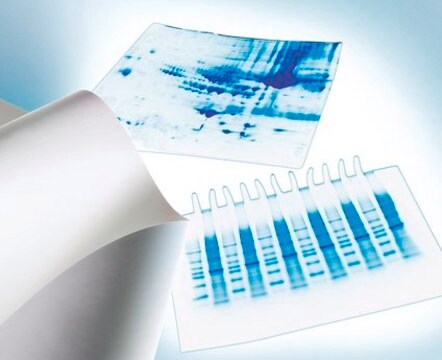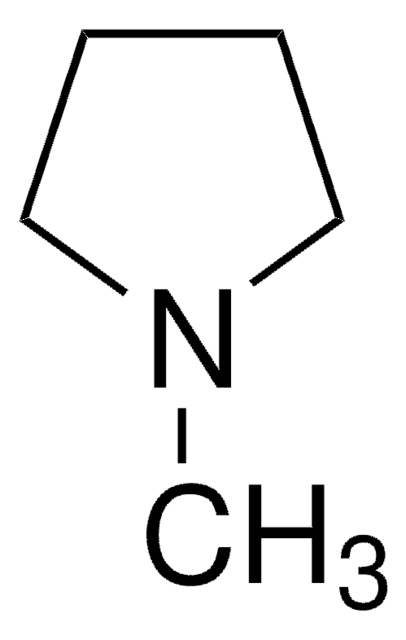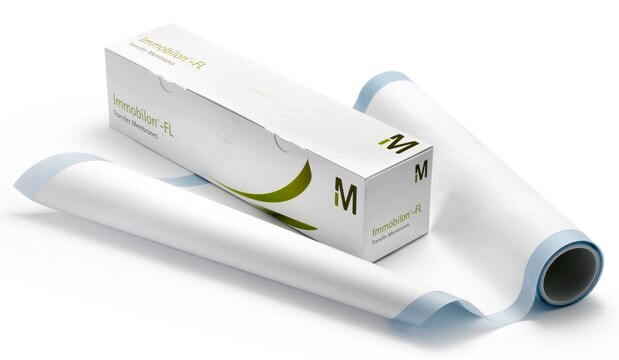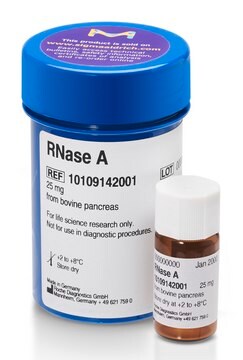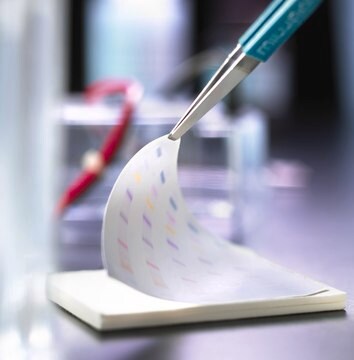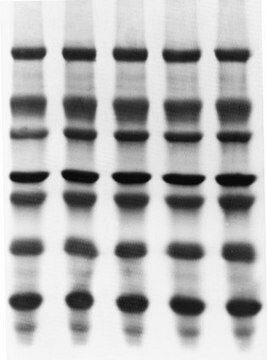P2938
Immobilon®-P Polyvinylidene difluoride membranes
size 26.5 cm × 375 cm
Sinónimos:
PVDF
Iniciar sesiónpara Ver la Fijación de precios por contrato y de la organización
About This Item
Código UNSPSC:
41105339
NACRES:
NA.25
Productos recomendados
¿Está buscando productos similares? Visita Guía de comparación de productos
Aplicación
Immobilon-P Polyvinylidene difluoride membrane has been used in western blotting for the transfer of proteins after sodium dodecyl sulfate–polyacrylamide gel electrophoresis (SDS-PAGE).
Polyvinylidene difluoride membranes are popular membranes for immunoblotting (Western blotting), and sequencing of proteins. The basis of protein binding to PVDF is believed to be due to hydrophobic interactions. PVDF membranes for Western blotting are available in the most commonly used 0.45 μm pore size. PVDF membranes have a greater protein binding capacity, are more durable and more solvent resistant than nitrocellulose.
Información legal
Immobilon is a registered trademark of Merck KGaA, Darmstadt, Germany
Código de clase de almacenamiento
11 - Combustible Solids
Clase de riesgo para el agua (WGK)
WGK 3
Punto de inflamabilidad (°F)
Not applicable
Punto de inflamabilidad (°C)
Not applicable
Equipo de protección personal
Eyeshields, Gloves, type N95 (US)
Certificados de análisis (COA)
Busque Certificados de análisis (COA) introduciendo el número de lote del producto. Los números de lote se encuentran en la etiqueta del producto después de las palabras «Lot» o «Batch»
¿Ya tiene este producto?
Encuentre la documentación para los productos que ha comprado recientemente en la Biblioteca de documentos.
Los clientes también vieron
Cross-phosphorylation between Arabidopsis thaliana sucrose nonfermenting 1-related protein kinase 1 (AtSnRK1) and its activating kinase (AtSnAK) determines their catalytic activities.
Crozet P, et al.
The Journal of Biological Chemistry, 285, 12071-12077 (2010)
Clare M Hamilton et al.
Infection and immunity, 77(6), 2488-2498 (2009-04-01)
Parasitic worms and molecules derived from them have powerful anti-inflammatory properties and are shown to have therapeutic effects on inflammatory diseases. The helminth Fasciola hepatica has been reported to suppress antigen-specific Th1 responses in concurrent bacterial infections, thus demonstrating its
Nuestro equipo de científicos tiene experiencia en todas las áreas de investigación: Ciencias de la vida, Ciencia de los materiales, Síntesis química, Cromatografía, Analítica y muchas otras.
Póngase en contacto con el Servicio técnico